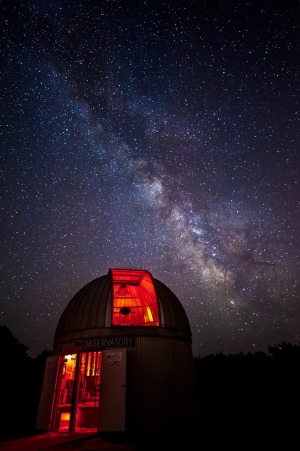
Summer Stargazing Nights
- Where:
- Frosty Drew Observatory
- When:
- Friday July 8, 2016 at 7:30 p.m. - 10:00 p.m.
- Cost:
- $1 Suggested Donation per Person
Tonight is Stargazing Night at Frosty Drew Observatory and for the second Friday night consecutively around the new Moon we have a weather attack. Forecasts are calling for clouds, fog and drizzle for pretty much the entire weekend with a lingering threat of t-storms. Though we are certainly in need of some rain, it is quite unfortunate that it is happening on Friday nights around the new Moon as tonight’s 20% waxing crescent phase would have offered fabulous lunar viewing in twilight, with moon set happening early enough to revel in the fabulous summertime Milky Way.
We will open the Sky Theatre from 7:30 p.m. – 10:00 p.m. tonight. On display will be a showcase of celestial objects we photograph at Frosty Drew Observatory with a commentary and discussion on general astronomy. The Observatory will be open for tours of our equipment for those interested in how everything works. On the offbeat chance that skies clear enough to catch a view of the Moon, Jupiter or Saturn we will open a telescope and sneak a peek.
Overall, tonight would have been the night to be out. Though clouds, drizzle and fog will make crash our awesomeness. If you’re looking for a quick astro-fix or just have a free Friday night to geek out with the Frosty Drew astronomers, then swing over and chat about all the amazing things happening in astro and catch up on your geek.
-------------------------------------------------------------------------
Weekly Happenings
Scott MacNeill
While sitting out the dismal weather tonight, kick back with a comfy blanket or a fluffy kitty and tune into NASA TV at 11:30 p.m. to catch the arrival of the new International Space Station (ISS) crew. Launching this past Wednesday night from Baikonur Cosmodrome in Kazakhstan on the Souyuz MS spacecraft, the crew took the long route, completing 34 loops around Earth in preparation for tonight’s arrival. The new crew compliment consists of NASA astronaut Kate Rubins, Roscosmos cosmonaut Anatoly Ivanishin, and JAXA astronaut Takuya Onishi which will bring the station compliment to six and make up the Expedition 48 crew. The next four months will see over 250 science investigations in biology, Earth science, human research, physical sciences, and technology. Additionally, Expedition 48 will install the first international docking adapter onto the station, which will feature on board systems for automated docking, accommodating US commercial crew spacecraft as well as any future international spacecraft. Expedition 48 will also install a needed battery boost compliments of a Japanese spacecraft, which will upgrade the old nickel-hydrogen batteries that store electricity generated by the station’s solar arrays to newer lithium-ion batteries. So sit back and enjoy some rock star international collaboration of our only continuously inhabited space destination all in the name of exploration. NASA TV coverage starts at 11:30 p.m. tonight!

If you haven’t yet heard, the NASA Juno mission, which has been traveling the Solar System for the past five years, successfully acquired orbit around Jupiter this past Monday night as planned. The Juno mission is tasked with studying Jupiter’s massive magnetic field, atmosphere, core, auroras, and more; with the goal of learning a bit about the origins of planetary formation in the Solar System and beyond. Monday’s orbital insertion maneuver placed Juno in a huge elliptical 53.4 day orbit around Jupiter, with a brief trajectory correction happening on Wednesday, July 13th to refine the spacecraft’s orbit around the monster planet . After which, science instrument calibration and testing will commence over the next month, just in time for the next close Jupiter approach on August 27th, which will allow for the first collection of science data. Juno will make it’s final engine burn on October 19th, placing Juno into a much closer 14 day science orbit around Jupiter. Though calibration and testing periods may be quiet, keep an eye out for new discoveries and images later this summer and autumn. Follow along with the Juno mission online
-Scott

